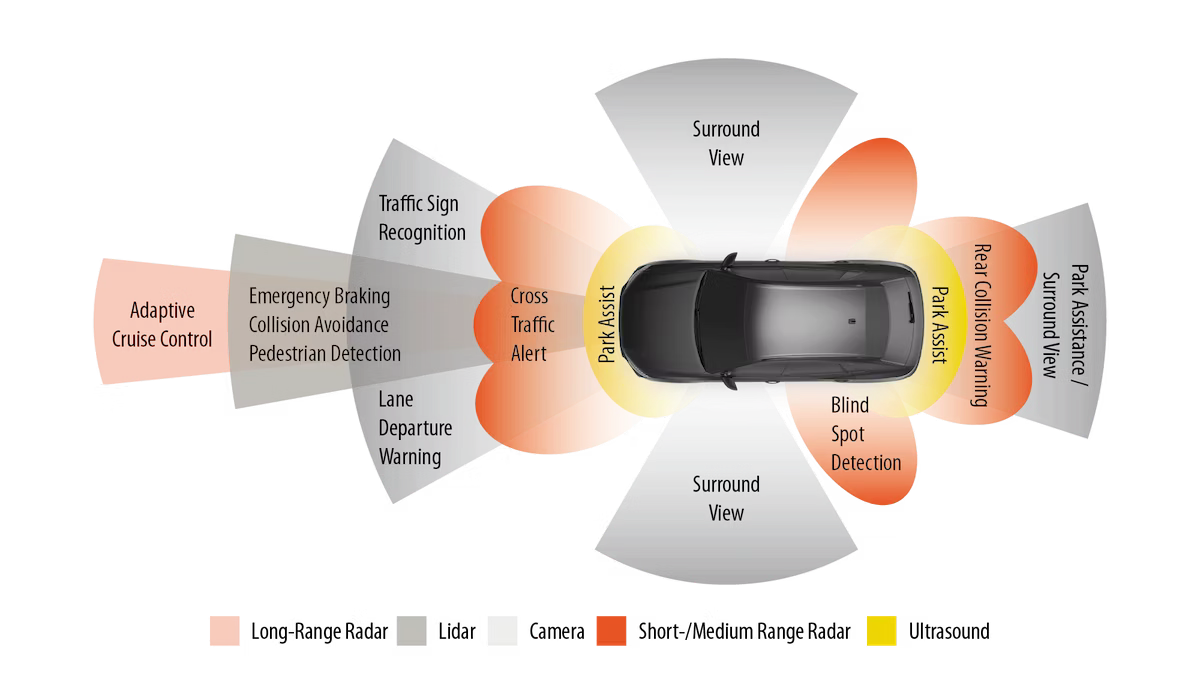Advanced Driver Assistance Systems

ADAS
ADAS stands for Advanced Driver Assistance Systems. It refers to a set of technologies and features designed to assist drivers and enhance vehicle safety. ADAS utilizes various sensors, cameras, and processing capabilities to monitor the vehicle’s surroundings, detect potential hazards, and provide real-time alerts or assistive actions to the driver.
Some common examples of ADAS features include:
- Adaptive Cruise Control (ACC): It automatically adjusts the vehicle’s speed to maintain a safe distance from the vehicle ahead.
- Lane Departure Warning (LDW): It alerts the driver when the vehicle starts to deviate from its lane without signaling.
- Automatic Emergency Braking (AEB): It detects potential collisions and applies brakes autonomously or provides warnings to avoid or mitigate an accident.
- Blind Spot Detection (BSD): It uses sensors to monitor the vehicle’s blind spots and provides warnings if there are other vehicles in those areas.
- Parking Assistance: It assists the driver in parking maneuvers, such as providing visual or audio cues to help navigate into parking spaces.
- Forward Collision Warning (FCW): It alerts the driver if the vehicle is approaching another vehicle or obstacle too quickly.
- Traffic Sign Recognition (TSR): It uses cameras or sensors to detect and recognize traffic signs, displaying relevant information to the driver.
These are just a few examples of the many ADAS features available in modern vehicles. The primary goal of ADAS is to improve safety, reduce accidents, and provide drivers with additional assistance and convenience while driving.
ADAS Calibration after Collision Repair
Given the crucial role that ADAS plays in enhancing safety, it’s essential to ensure these systems function correctly, especially after a collision repair. This requires ADAS calibration, a meticulous process that involves adjusting the ADAS sensors and cameras to ensure they provide accurate information to the vehicle’s control modules.
ADAS calibration becomes necessary after a collision because an impact can dislodge or misalign the sensors and cameras used by the ADAS features. This misalignment may cause the systems to function incorrectly, giving inaccurate alerts or failing to activate when needed. Therefore, a critical part of the post-collision repair process involves recalibrating these systems to restore them to their original factory settings.
The calibration process varies depending on the vehicle make, model, and the specific ADAS features it has. However, it typically involves two types of calibration: static and dynamic.
Static calibration is performed in a controlled environment, such as a garage or a workshop. The vehicle is placed in a specific position in relation to a calibration target, and the ADAS systems are then adjusted using specialized software.
Dynamic calibration, on the other hand, is done on the road. It involves driving the vehicle at specific speeds and conditions so that the onboard computer can recalibrate the ADAS systems using real-time data.
This calibration process is a delicate task that requires specialized knowledge, tools, and training. As such, it is often performed by professional technicians at a dealership or a certified collision repair center.
As technology continues to evolve, ADAS is set to become a standard feature in most vehicles, promising a future where roads are safer, and accidents are significantly reduced. However, the sophistication of these systems necessitates regular maintenance and calibration, especially after a collision, to ensure they function as intended.
In essence, ADAS represents a significant leap in vehicle safety, transforming not just the driving experience but also how vehicles are serviced and maintained. Therefore, it is important for vehicle owners to understand what ADAS is and the importance of calibration after a collision repair, highlighting the crucial role of professional and certified repair services in maintaining vehicle safety and performance.
